C Programming and Data Structures: Unit IV: b. Hashing
Collision Handling
Definition, Operations, Structure, Example C programs
Definition: If collisions occur then it should be handled by applying some techniques, such techniques are called collision handling techniques.
Collision Handling
AU:
Dec.-15, 18, May - 16, 17, 19, Marks 16
Definition:
If collisions occur then it should be handled by applying some techniques, such
techniques are called collision handling techniques.

1. Chaining
1.
Chaining without replacement
In
collision handling method chaining is a concept which introduces an additional
field with data i.e. chain. A separate chain table is maintained for colliding
data. When collision occurs we store the second colliding data by linear
probing method. The address of this colliding data can be stored with the first
colliding element in the chain table, without replacement.
For
example consider elements,
131,
3, 4, 21, 61, 6, 71, 8, 9
From
the example, you can see that the chain is maintained the number who demands
for location 1. First number 131 comes we will place at index 1. Next comes 21
but collision occurs so by linear
probing we will place 21 at index 2, and chain is maintained by writing 2 in
chain table at index 1 similarly next comes 61 by linear probing we can place
61 at index 5 and chain will be maintained at index 2. Thus any element which
gives hash key as 1 will be stored by linear probing at empty location but a
chain is maintained so that traversing the hash table will be efficient.
The
drawback of this method is in finding the next empty location. We are least
bothered about the fact that when the element which actually belonging to that
empty location cannot obtain its location. This means logic of hash function
gets disturbed.

2.
Chaining with replacement
The
method of chaining without replacement has a drawback of loosing the meaning of
the hash function, to overcome this drawback the method known as chaining with
replacement is introduced. Let us discuss the example to understand the method.
Suppose we have to store following elements:
131,
21, 31, 4, 5
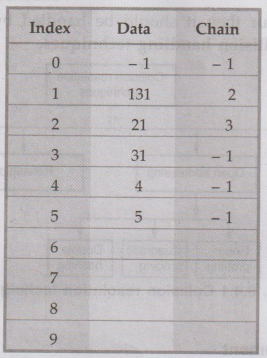
Now
next element is 2. As hash function will indicate hash key as 2 but already at
index 2. We have stored element 21. But we also know that 21 is not of that
position at which currently it is placed.
Hence
we will replace 21 by 2 and accordingly chain table will be updated. See the
table:

The
value -1 in the hash table and chain table indicate the empty location. The
advantage of this method is that the meaning of hash function is preserved. But
each time some logic is needed to test the element, whether it is at its proper
position.
2. Open Addressing
Open
addressing is a collision handling technique in which the entire hash table is
searched in systematic way for empty cell to insert new item if collision occurs.
Various
techniques used in open addressing are
1.
Linear probing
2.
Quadratic probing
3.
Double hashing
1.
Linear probing
When
collision occurs i.e. when two records demand for the same location in the hash
table, then the collision can be solved by placing second record linearly down
wherever the empty location is found.
For
example

In
the hash table given in Fig. 6.4.3 the hash function used is number % 10. If
the first number which is to be placed is 131 then 131 % 10 = 1 i.e. remainder
is 1 so hash key = 1. That means we are supposed to place the record at index
1. Next number is 21 which gives hash key 1 as 21 % 10 = 1. But already 131 is
placed at index 1. That means collision is occurred. We will now apply linear
probing. In this method, we will search the place for number 21 from location
of 131. In this case we can place 21 at index 2. Then 31 at index 3. Similarly
61 can be stored at 6 because number 4 and 5 are stored before 61. Because of
this technique, the searching becomes efficient, as we have to search only
limited list to obtain the desired number.
Ex.
6.4.1: Implement the hash table and perform collision handling by linear
probing
Sol.
:
#include
<stdio.h>
#include<conio.h>
void
display(int a[ ], int n)
{
//
Displaying complete hash table
for
(int i = 0; i < n; i++)
{
printf("\n
%d %d",i,a[i]);
}
}
void
Linear_prob(int table[ ], int tsize,int num)
{
int
key = num % tsize;//Computing the hash key using hash function
while
(table[key]!= -1)//if empty slot is not found
{
key
(key+1)%tsize;//then move linearly dow in search of empty slot
}
table[key]=num
;//if empty slot gets then insert the element
display(table,
tsize);
}
int
main()
{
int
SIZE = 10;// Size of the hash table
int
num;
int
hash_table[SIZE];
char
ans;
//
Initializing the hash table
for
(int i = 0; i < SIZE; i++)
{
hash_table[i]
= -1;//-1 indicates empty slot
}
do
{
printf("\nEnter
The Number: ");
scanf("%d",
&num);//This element is to be inserted in hash table
Linear_prob(hash_table,SIZE,num);
printf("\n
Do U Wish To Continue? (y/n)");
ans
= getch();
}while(ans=='y');
return
0;
}
Output
Enter
The Number: 131
0
-1
1
131
2
-1
3
-1
4
-1
5
-1
6
-1
7
-1
8
-1
9
-1
Do
U Wish To Continue?(y/n)
Enter
The Number: 21
0
-1
1
131
2
21
3
-1
4
-1
5
-1
6
-1
7
-1
8
-1
9
-1
Do
U Wish To Continue?(y/n)
Enter
The Number: 3
1-
0
1
131
2
21
3
3
4
-1
5
-1
6
-1
7
-1
8
-1
9
-1
Do
U Wish To Continue? (y/n)
Enter
The Number: 4
0
-1
1
131
2
21
3
3
4
4
5
-1
6
-1
7
-1
8
-1
9
-1
Do
U Wish To Continue?(y/n)
Enter
The Number: 5
0
-1
1
131
2
21
3
3
4
4
5
LO
5
6
-1
7
-1
8
-1
9
-1
Do
U Wish To Continue? (y/n)
Enter
The Number: 8
0
-1
1
131
2
21
3
3
4
4
5
5
6
-1
7
-1
8
8
9
-1
Do
U Wish To Continue?(y/n)
Enter
The Number: 9
0
-1
1
131
2
21
3 3
4
4
5
5
6
-1
7
-1
8
8
9
9
Do
U Wish To Continue?(y/n)
Enter
The Number: 18
0
18
1
131
2
21
3
3
4
4
5
5
6
-1
7
-1
8
8
9
9
Do
U Wish To Continue?(y/n)
Enter
The Number: 33
0
18
1
131
2
21
3
3
4
4
5
5
6
33
7
-1
8 8
9
9
Do
U Wish To Continue?(y/n)
Problem
with linear probing
One
major problem with linear probing is primary clustering. Primary clustering is
a process in which a block of data is formed in the hash table when collision
is resolved.
For
example:
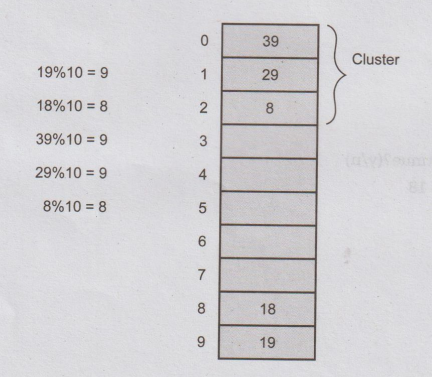
This
clustering problem can be solved by quadratic probing.
2.
Quadratic probing
Quadratic
probing operates by taking the original hash value and adding successive values
of an arbitrary quadratic polynomial to the starting value. This method uses
following formula -
Hi(key)
= (Hash(key)+i2)%m
where
m can be a table size or any prime number.
For
example: If we have to insert following elements in the hash
table with table size 10: 37, 90, 55, 22, 11, 17, 49, 87.
We
will fill the hash table step by step

Now
if we want to place 17 a collision will occur as 17%10-7 and bucket 7 has
already an element 37. Hence we will apply quadratic probing to insert this
record in the hash table.
Hi(key)
= (Hash(key)+i2)%m
we
will choose value i = 0, 1, 2, whichever is applicable.
Consider
i = 0 then
(17+02) %10 = 7
(17+12) %10 = 8, when i = 1
The
bucket 8 is empty hence we will place the element at index 8.
Then
comes 49 which will be placed at index 9.
49%10
= 9
Now
to place 87 we will use quadratic probing.
(87+0)%10
= 7
(87
+ 1)%10 = 8 ... but already occupied
(87
+22)%10 = 1 ... already occupied
(87+32)%10 = 6... this slot is free
We
place 87 at 6th index.

It
is observed that if we want to place all the necessary elements in the hash
table the size of divisor (m) should be twice as large as total number of
elements.
Ex.
6.4.2 Write a C program to implement quadratic probing.
Sol.
:
#include
<stdio.h>
#include<conio.h>
void
display(int a[], int n)
{
//
Displaying complete hash table
for
(int i = 0; i < n; i++)
{
printf("\n
%d %d",i,a[i]);
}
}
void
Quadratic_prob(int table[], int tsize,int num)
{
int
key = num % t using size;//computing the hash key mod function
//
Insert in the table if there is empty slot
if
(table[key] == -1)
table[key]
= num;
else.
{
for
(int i = 0; i < tsize; i++)//using formula for quadratic probing
{
int
index = (key + i* i) % tsize;
if
(table[index] == -1)//if empty slot is found
{
table[index]
break; = num;//then insert element at that index
break;
}
}
}
display(table,
tsize);
}
int
main()
{
int
SIZE = 10;// Size of the hash table
int
num;
int
hash_table[SIZE];
char
ans;
//
Initializing the hash table
for
(int i = 0; i < SIZE; i++)
{
hash_table[i]
= -1;//-1 indicates empty slot
}
do
{
printf("\nEnter
The Number: ");
scanf("%d",
&num);//Number to be inserted in the hash table
Quadratic
prob(hash_table,SIZE,num);
printf("\n
Do U Wish To Continue?(y/n)");
ans
= getch();
while(ans=
='y');
return
0;
}
Output
Enter
The Number: 37
0
-1
1
-1
2
-1
3
-1
4
-1
5
-1
6
-1
7
37
8
-1
9
-1
Do
U Wish To Continue?(y/n)
Enter
The Number: 90
0
90
1
-1
2
-1
3
-1
4
-1
5
-1
6
-1
7
37
8
-1
9
-1
Do
U Wish To Continue?(y/n)
Enter
The Number: 55
0
90
1
-1
2
-1
3
-1
4
-1
5
55
6
-1
7
37
8
-1
9
-1
Do
U Wish To Continue?(y/n)
Enter
The Number: 22
0
90
1
-1
2
22
3
-1
4
-1
5
55
6
-1
7
37
8
-1
9
-1
Do
U Wish To Continue?(y/n)
Enter
The Number: 11
0
90
1
11
2
22
3
-1
4
-1
5
55
6
-1
7
37
8
-1
9
-1
Do
U Wish To Continue?(y/n)
Enter
The Number: 17
0
90
1
11
2
22
3
-1
4
-1
5
55
6
-1
7
37
8
17
9
-1
Do
U Wish To Continue?(y/n)
Enter
The Number: 49
0
90
1
11
2
22
3
-1
4
-1
5
55
6
-1
7
37
8
17
9
49
Do
U Wish To Continue?(y/n)
Enter
The Number: 87
0
90
1
11
2
22
3
-1
4
-1
5
55
6
87
7
37
8
17
9
49
Do
U Wish To Continue?(y/n)
3.
Double hashing
Double
hashing is technique in which a second hash function is applied to the key when
a collision occurs. By applying the second hash function we will get the number
of positions from the point of collision to insert.
There
are two important rules to be followed for the second function :
•
It must never evaluate to zero.
•
Must make sure that all cells can be probed.
The
formula to be used for double hashing is
H1(key)
= key mod tablesize
H2(key)
= M (key mod M)
where
M is a prime number smaller than the size of the table.
Consider
the following elements to be placed in the hash table of size 10
37,
90, 45, 22, 17, 49, 55
Initially
insert the elements using the formula for H1(key).
Insert
37, 90, 45, 22.
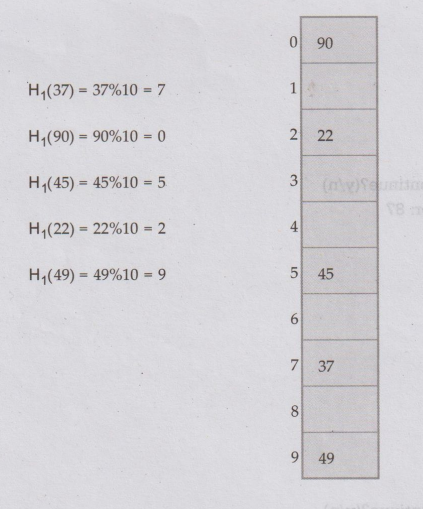
Now
if 17 is to be inserted then
H1(17)
= 17%10 = 7
H2(key)
= M - (key%M)
Here
M is a prime number smaller than the size of the table. Prime number smaller
than table size 10 is 7.
Hence
M = 7
H2(17)
= 7 (17%7) = 7 – 3 = 4

That
means we have to insert the element 17 at 4 places from 37. In short we have to
take 4 jumps. Therefore the 17 will be placed at index 1.
Now
to insert number 55.
H1
(55) 55%10 = 5... collision
H2(55)
= 7-(55%7) = 7 - 6 = 1
That
means we have to take one jump from index 5 to place 55. Finally the hash table
will be -

Comparison
of quadratic probing and double hashing
The
double hashing requires another hash function whose probing efficiency is same
as some another hash function required when handling random collision.
The
double hashing is more complex to implement than quadratic probing. The
quadratic probing is fast technique than double hashing.
Ex.
6.4.3 Give the input {4371, 1323, 6173, 4199, 4344, 9679, 1989} and hash
function X(mod 10), show the results for the following:
i)
Open addressing hash table using linear probing
ii)
Open addressing hash table using quadratic probing
iii)
Open addressing hash table with second hash function h2 (X) = 7 - (X
mod 7).
AU:
Dec.-18, Marks 15
Sol.
i) Open addressing hash table using linear probing :
We
assume mod function as mod 10.
4371
mod 10 = 1
1323
mod 10 = 3
6173
mod 10 = 3 collision occurs
Hence
by linear probing we will place 6173 at next empty location. That is, at
location 4.
4199
mod 10 = 9
4344
mod 10 = 4 but location 4 is not empty.
Hence
we will place 4344 at next empty location i.e. 5,
9679
mod 10 = 9 collision occurs so place at next location at 0. The hash table is
of size 10. Hence we find the next empty location by rolling the table in
forward direction.
1989
mod 10 = 9 collision occurs, so we find the next empty location at index 2.
The
hash table will then be

ii)
Open addressing hash table using quadratic probing
In
quadratic probing we consider the original hash key and then add an arbitrary
polynomial. This sum is then considered for hash function. The hash function
will be
H(Key)
= (Key +i2) % me-
where
m can be a table size
If
we assume m = 10, then the numbers can be inserted as follows -

iii)
Open addressing hash table with second hash function
Step
1:
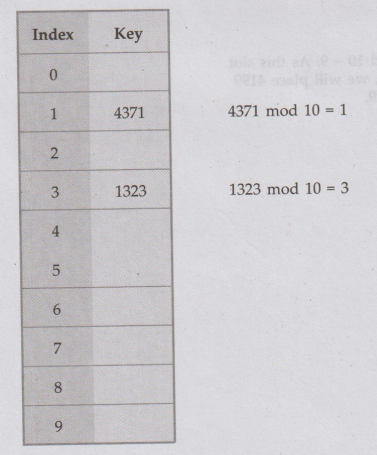
Step 2:
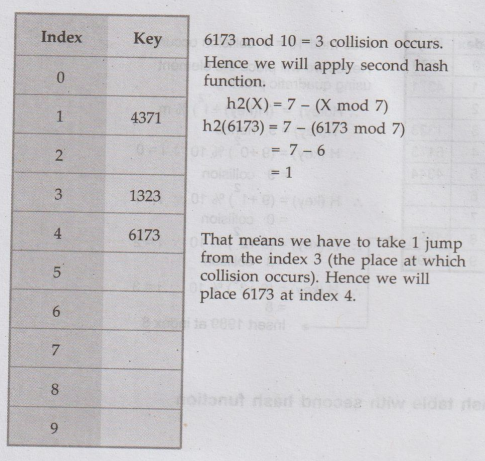
Step 3:

Step 4:
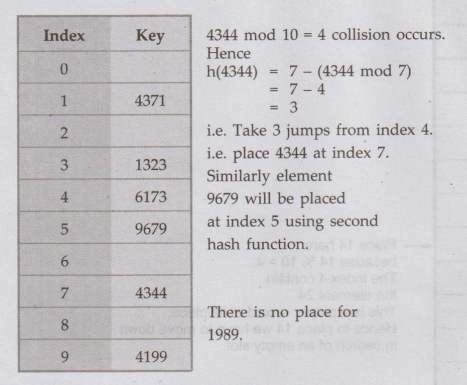
Ex.
6.4.4 What do you understand by collision in hashing? Represent the following
keys in memory using linear probing with or without replacement. Use modulo
(10) as your hashing function: (24, 13, 16, 15, 19, 20, 22, 14, 17, 26, 84, 96)
Sol.
Collision in hashing - Refer section 6.4.
i)
Linear probing with replacement
We
will consider the hash function as modulo (10) for the hash table size 12, that
is from 0 to 11. In linear probing with replacement, we first find the probable
position of the key element using hash function. If the location which we
obtain from hash function is empty then place the corresponding key element at
that location. If the location is not empty and the key element which is
present at that location belongs to that location only then, move down in
search of empty slot. Place the record at the empty slot.
If
the location contains a record which does not belong to that location then
replace that record by the current key element. Place the replaced record at
some empty slot, which can be obtained by moving linearly down.

We
get the empty location at index 7. Hence 14 is placed at index 7.


Ex.
6.4.5: Consider a hash table with 9 slots. The hash function is h(k) = k mod 9.
The following keys are inserted in the order 5, 28, 19, 15, 20, 33, 12, 17, 10.
Draw the contents of the hash table when the collisions are resolved by
(i)
Chaining (ii) Linear probing (iii) Double hashing.
The
second hash function h2(x) = 7-(x mod 7).
AU:
May-19 Marks 13
Sol.:
i) Chaining

Similarly
remaining elements can be placed. When collision occurs, double hashing is
applied.

3. Rehashing
Rehashing
is a technique in which the table is resized, i.e., the size of table is
doubled by creating a new table. It is preferable if the total size of table is
a prime number. There are situations in which the rehashing is required –
•
When table is completely full.
•
With quadratic probing when the table is filled half.
•
When insertions fail due to overflow.
In
such situations, we have to transfer entries from old table to the new table by
recomputing their positions using suitable hash functions.
Consider
we have to insert the elements 37, 90, 55, 22, 17, 49 and 87. The table size is
10 and I will use hash function,

Now
this table is almost full and if we try to insert more elements collisions will
occur and eventually further insertions will fail. Hence we will rehash by
doubling the table size. The old table size is 10 then we should double this
size for new table, that becomes 20. But 20 is not a prime number, we will
prefer to make the table size as 23. And new hash function will be

Now
the hash table is sufficiently large to accommodate new insertions.
Advantages
1.
This technique provides the programmer a flexibility to enlarge the table size
if required.
2.
Only the space gets doubled with simple hash function which avoids occurrence
of collisions.
Review Questions
1. Explain the following collision resolution strategies with
example.
i) Separate chaining ii) Linear probing iii) Quadratic probing
AU: Dec.-15, Marks 16
2. Explain the following: Rehashing.
AU: May-16, Marks 8
3. Illustrate with example the open addressing and chaining
methods of collision resolution techniques in hashing. AU: May-17, Marks 16
4. Explain open addressing in detail. AU: Dec.-18, Marks 6
5. When do you perform rehashing? Illustrate with example.
AU: May-19, Marks 8
C Programming and Data Structures: Unit IV: b. Hashing : Tag: : Definition, Operations, Structure, Example C programs - Collision Handling
Related Topics
Related Subjects
C Programming and Data Structures
CS3353 3rd Semester EEE, ECE Dept | 2021 Regulation | 3rd Semester EEE Dept 2021 Regulation
